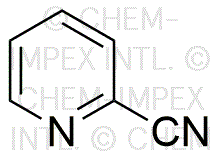2-Cyanopyridine is widely utilized in research focused on:
- Synthesis of Pharmaceuticals: This compound serves as a key intermediate in the production of various pharmaceutical agents, including anti-inflammatory and anti-cancer drugs, enhancing the efficiency of drug development processes.
- Ligand Development: In coordination chemistry, it is used to create ligands that can form stable complexes with metals, which are essential in catalysis and materials science.
- Agricultural Chemicals: It plays a role in the formulation of agrochemicals, particularly in the synthesis of pesticides and herbicides, contributing to improved crop protection and yield.
- Research Reagents: 2-Cyanopyridine is employed as a reagent in organic synthesis, facilitating various reactions that are crucial for developing new materials and compounds in laboratories.
- Analytical Chemistry: This compound is used in chromatographic techniques for the analysis of complex mixtures, providing reliable results in quality control and research applications.
General Information
Properties
Safety and Regulations
Applications
2-Cyanopyridine is widely utilized in research focused on:
- Synthesis of Pharmaceuticals: This compound serves as a key intermediate in the production of various pharmaceutical agents, including anti-inflammatory and anti-cancer drugs, enhancing the efficiency of drug development processes.
- Ligand Development: In coordination chemistry, it is used to create ligands that can form stable complexes with metals, which are essential in catalysis and materials science.
- Agricultural Chemicals: It plays a role in the formulation of agrochemicals, particularly in the synthesis of pesticides and herbicides, contributing to improved crop protection and yield.
- Research Reagents: 2-Cyanopyridine is employed as a reagent in organic synthesis, facilitating various reactions that are crucial for developing new materials and compounds in laboratories.
- Analytical Chemistry: This compound is used in chromatographic techniques for the analysis of complex mixtures, providing reliable results in quality control and research applications.
Documents
Safety Data Sheets (SDS)
The SDS provides comprehensive safety information on handling, storage, and disposal of the product.
Product Specification (PS)
The PS provides a comprehensive breakdown of the product’s properties, including chemical composition, physical state, purity, and storage requirements. It also details acceptable quality ranges and the product's intended applications.
Certificates of Analysis (COA)
Search for Certificates of Analysis (COA) by entering the products Lot Number. Lot and Batch Numbers can be found on a product’s label following the words ‘Lot’ or ‘Batch’.
*Catalog Number
*Lot Number
Certificates Of Origin (COO)
This COO confirms the country where the product was manufactured, and also details the materials and components used in it and whether it is derived from natural, synthetic, or other specific sources. This certificate may be required for customs, trade, and regulatory compliance.
*Catalog Number
*Lot Number
Safety Data Sheets (SDS)
The SDS provides comprehensive safety information on handling, storage, and disposal of the product.
DownloadProduct Specification (PS)
The PS provides a comprehensive breakdown of the product’s properties, including chemical composition, physical state, purity, and storage requirements. It also details acceptable quality ranges and the product's intended applications.
DownloadCertificates of Analysis (COA)
Search for Certificates of Analysis (COA) by entering the products Lot Number. Lot and Batch Numbers can be found on a product’s label following the words ‘Lot’ or ‘Batch’.
*Catalog Number
*Lot Number
Certificates Of Origin (COO)
This COO confirms the country where the product was manufactured, and also details the materials and components used in it and whether it is derived from natural, synthetic, or other specific sources. This certificate may be required for customs, trade, and regulatory compliance.


